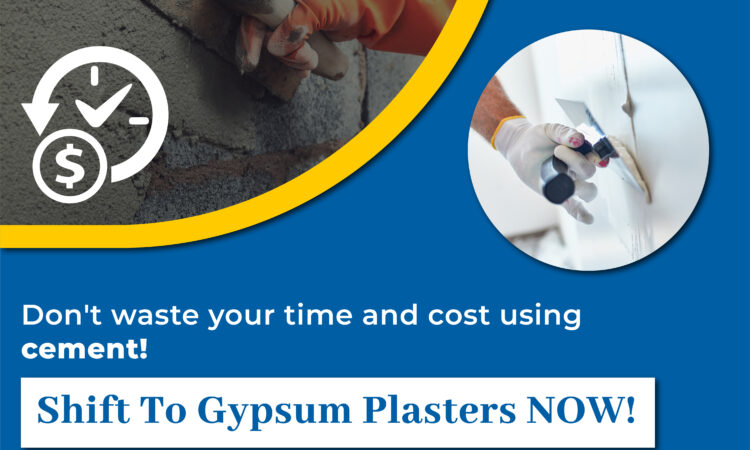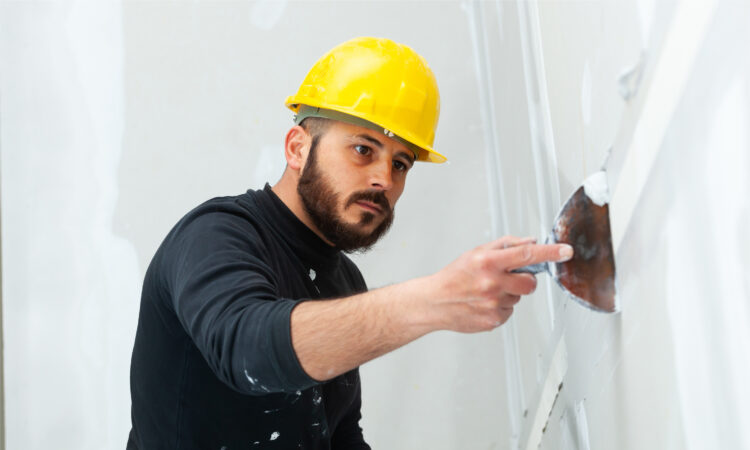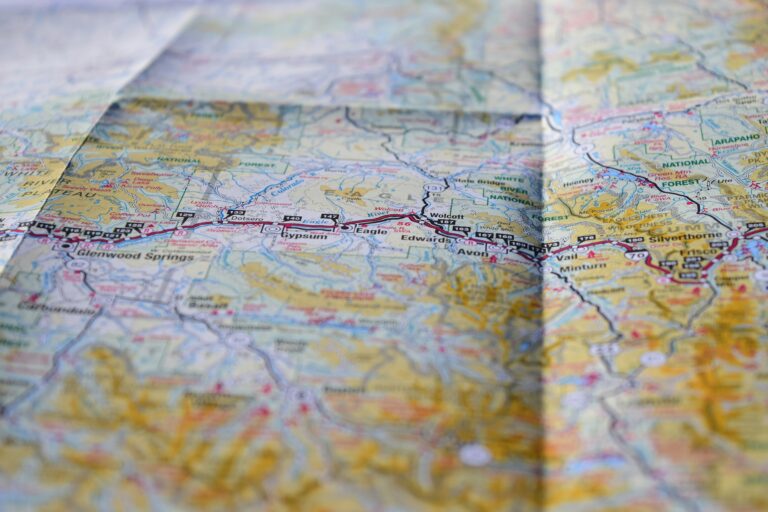Being in the construction industry for almost a decade, we see that there is a lack of awareness about modern, alternative construction materials like the gypsum plasters. Such materials present greater advantages and benefits than conventional ones. Particularly when the cost of traditional construction materials like cement, steel, etc. are surging at unanticipated rates, awareness of modern materials like gypsum plaster is important. Such an awareness would help builders, construction companies and building owners reduce the cost of construction, as well as complete the construction at the stipulated date and time of the year.
What is plastering?
Plasters are a stripy material that is used as a cover for walls, ceilings, and partitions. In simple terms, plasters are used as a cover against masonry surfaces. They are mostly used for protective purposes, while at times are demanded use in decorative means. As a protective material, plasters serve as a cover protecting the underlying stone, brick, etc. from direct wear and tear. They also protect walls against natural disasters and devastations like high-speed winds, heavy rains, and harmful gases. When used for decorative purposes, plasters help builders produce an appealing, aesthetic cover to improve the overall appearance of the building and the walls.
Types of plasters in the market
There are various types of plasters available in the market. We have listed a few of them for your reference.
Cement plasters
Cement plastering involves applying a mix of portland cement, sand, and water. They serve both as internal and external plasters and are used for decorative and protective purposes. The sand to cement ratio varies depending on the purpose from 3:1 to sometimes 8:1. Cement plasters require that they be sprayed with water for 15 to 21 days to let them settle slowly. This means cement plasters take at least 15 days to gain their inherent properties. The concerns about climate change and reducing carbon emissions are growing across the world. The cement industry contributes to 8% of global greenhouse gas emissions. So, builders and construction companies involved in the construction of green buildings are in a constant push to shift to alternative, eco-friendly plasters like gypsum plasters.
Gypsum Plasters
Gypsum is a naturally occurring mineral formed in abundance in the lakes and sea beds. They are deposited in the layers of sedimentary rocks. The chemical composition of gypsum is CaSO4.2H2O. It contains 21% of water in its composition. This is an important consideration as the presence of this crystalline water offers gypsum, the fire-resistant properties.
Gypsum plasters have evolved as a sustainable alternative to cement plasters. Mainly, because they are a natural material and enable the construction of greener buildings. More importantly, gypsum plasters consume lower resources in terms of fuel, water, and electricity when compared to cement plasters. When a wall is plastered with cement plasters, they require the application of putty before painting the wall. This is because cement plastering produces a coarse, rough surface. On the other hand, gypsum plasters produce a smooth surface and so do not require a putty application before painting. So, gypsum plasters have evolved as a sustainable replacement for the 2-step cement plastering process.
Lime Plasters
Lime plasters are obtained by mixing slaked lime with sand and the ratio of lime to sand is mostly 1:2 or 1:3. Water is also added to obtain a fine paste. Lime plasters are one of the oldest used plastering substances and are commonly found in buildings of historic significance. This was so because during those days people made quicklime by heating limestone and this was an essential part of their tradition.
Stucco Plasters
Stucco is mainly used as an exterior plaster. It adds a decorative, textured finish to the wall. There are two ways of using stucco- 1 coat method and 3 coat method. In the 3 coat method, the base coat is made from cement, sand, and water. Fiberglass and acrylic glass are further added to increase their strength and water resistance. The finishing coat is one of the two depending on the finish that is required – cement finish or acrylic material that goes over the base coat.
Evaluation of different plasters
Availability and cost
Cement plasters are available in 50 kg bags and require sand, water, and cement. The cost of cement in India, and perhaps across the world has been rising exponentially. Moreover, the National green tribunal has imposed restrictions on sand mining to stop the over-exploitation of sand.
Gypsum plasters require only gypsum and water. They do not require cement or sand. It is due to this reason that gypsum plasters have become a preferable alternative to cement plasters. Also, they reduce the 20% of the cost of construction or in other words save Rs.35 per.sq.ft.
Curing
Cement plasters require water curing. After plastering with cement, water has to be splashed for 15 to 21 days so as to ensure that it settles down. Sometimes cement plasters take up 21- 28 days to dry up and settle down. On the other hand, gypsum plasters dry up in 3 days and are paint-ready from then on.
Painting
Cement plasters require the application of POP or putty before being painted. Sometimes, they require whitewashing. On the other hand. Gypsum plasters are paint-ready and produce a smooth finish. They do not require POP/ putty and whitewashing. This in turn reduces the cost, time, and resources required in construction when compared to cement plasters.
Maintenance and repair
Cement plasters require periodic maintenance as they result in cracks. This is a challenge when used in high-rise buildings, educational institutions, government buildings, commercial buildings, hospitals, villas, townships, apartments, etc. as the utilization is generally higher. The wear and tear are also higher in cement plasters.
Gypsum has higher expansion properties, so they do not produce cracks on the surface. Maintenance requirements are lower for gypsum plasters when compared to cement plasters.
Aesthetics and appeal
The resultant surface produced at the end of cement plasters is rough and demands POP or putty application. When POP or putty is applied the wall thickness increases up to 20 to 35 mm. This reduces the carpet area. This increases the dead weight of high-rise buildings reducing their resistance to high-speed winds. Also, it is impossible to achieve leveled corners and right-angled edges with cement plasters.
On the other hand, gypsum plasters are applied directly to bricks and blocks. Gypsum plastering does not produce cracks, and so requires no putty, POP, or whitewashing. Leveled corners and perfect lines can be achieved using gypsum plasters. This improves the aesthetics and appeal of the building.
Humidity and temperature regulation
Studies show that while using gypsum plasters, the temperature is 2 to 3 degree Celsius lower than that of the atmospheric temperature. Because gypsum has high water content, it maintains the internal temperature even during summer. This reduces the requirements for air conditioning. On the other hand, cement emits heat and increases the heat of the room or the building. Gypsum plaster regulates the room temperature and maintains the humidity of the room, while cement plaster does not have the ability to regulate room temperature.
Are you worried about the rising construction costs? Are you struggling to complete the projects at the agreed-upon price? Or is it more difficult to handle labor shortages and surging wage rates? If you are a builder or a construction company struggling to handle one or all of the above, shifting to gypsum plasters would help you survive and thrive.
Kanish plasters is a leading gypsum plastering company with offices in all major cities across India. We undertake gypsum plastering for all kinds of buildings- educational institutions, government buildings, commercial buildings, hospitals, villas, townships, apartments, etc.
Visit www.kanishplasters.com to know more.
Contact +1800 208 9006 or write to us at [email protected].



